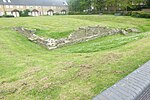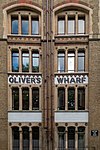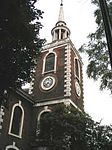St Peter's, Wapping, is a Grade I listed Anglican church in Wapping Lane, Wapping, London, E1W 2RW.
It was built in 1865–1939, designed by F. H. Pownall.The church was the first Anglican mission to the poor of London. Work was begun in 1856 by the Revd Charles Lowder MA and a group of priests, all were members of the Society of the Holy Cross. The Society had been founded a year earlier with the express purpose of banding priests to a common rule of life and prayer in mission service.Wapping was one of the poorest districts in London, a haunt of prostitutes and petty criminals, living alongside those who earned a precarious living from the docks.
Lowder's work began in Lower Well Alley (now the park by the James Orwell sports centre) and moved to an iron church in Calvert Street (now Tench Street). Lowder's group of Clergy and Sisters provided practical care through schools, clubs, cheap canteens and child care and spiritual care through a wide range of services, centred on the Mass at the Mission Churches.
In 1866 the new Church of St Peter was consecrated. Soon afterwards cholera struck the East End. Lowder organised Sisters of Mercy and others to care for the sick and raised funds for a tented hospital. The Priests and Sisters took great risks and worked without stint for the people of Wapping. At the end of the cholera people were calling Lowder, ‘the Father’ because he seemed like the father of the whole community.After Lowder's death in 1880, Maurice Bingham Adams was engaged to design extensions in his memory. In 1884-94 a mortuary, chapel and baptistry were all added.Further work was done to the church in the 1930s, and finished in 1940, only to be immediately destroyed by a bomb in the Blitz. Repairs were completed in 1949. The church was completely renovated in 1985.Now it is used for church services in the area of Wapping and has a regular Thursday attendance from the nearby school whom uses this church which is St Peter's London Docks Primary.












